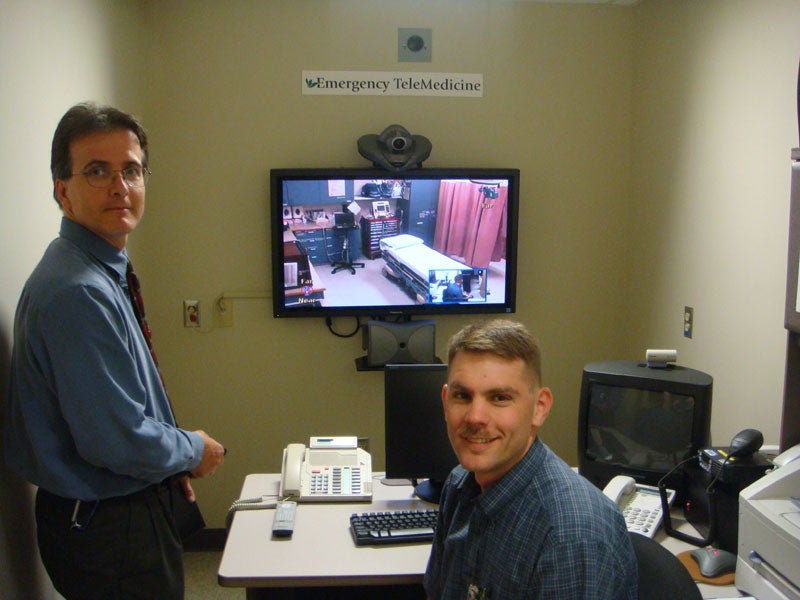How telehealth is changing the way America gets well.
"Broadband Innovations" is a four-part series that highlights groundbreaking broadband uses, and the people who employ the technology to preserve the past, reshape the future, and fulfill their dreams. This final story in the series focuses on residents of Washington State who receive medical and psychiatric care via video over the Internet.
Typically, obtaining medical care would mean transporting Moon, accompanied by two guards, from his cell at Coyote Ridge Corrections Center in Connell, Washington, to a caregiver in Spokane, 100 miles away. A second option would be to have a psychiatrist drive all the way from Spokane to the penitentiary for every consultation.
However, thanks to the Northwest Telehealth network, which uses broadband to provide health care to remote locations, Moon undergoes videoconferencing sessions with his psychiatrist without ever leaving the penitentiary. And he likes it better than meeting in person.
"When I'm in a room by myself, there is less pressure. It's like talking to the camera, which works for me since I find it more difficult to talk about my problems in person," he says.
Moon initially tried confiding in his fellow inmates, but found that it did more harm than good. "You can't just express yourself to anyone. They'll interpret it as weakness and take advantage of it." Having been in a couple of fights, he now tries to stick to himself.
"But it's important to have someone to talk to," he says.
The Benefits of Telehealth
About 50 of the 620 inmates at Coyote Ridge use the network for their health-care needs. Aside from saving tax dollars and improving safety by minimizing the transport of prisoners, the system also discourages prisoners from feigning symptoms to break the monotony of prison's daily routine.

"In my experience, 50 percent of the inmates that come to the ER don't need to be here," says Gram McGregor, emergency department manager at Deaconess Medical Center in Spokane.
His ER department is another one of 65 sites throughout eastern Washington and northern Idaho that are connected to the Northwest Telehealth network by broadband speeds of up to 100 megabits per second. Besides penitentiaries, his ER provides rural hospitals and other sites with remote consultations.
McGregor maintains that the remote service is not just about saving money--it's also about improving the quality of care. "Many rural clinics are understaffed. Whether they need an expert consult, a second opinion, or emergency advice, they need to be able to access it remotely," he says.
Prison Saved My Life

"Prison saved my life. The way I was eating and drinking, I wouldn't have lasted long," says Martinez, who also says he has been able to turn his health around through hard work and guidance from regular consultations via the telehealth network.
By exercising, Martinez has been able to decrease his insulin dependency by more than half. Through diabetes education in a group over the network, he has also learned how to care for his body and skin. Next he hopes to have a teleconsult with a dietician to work out a meal plan.
Diane Benfield, the dietician at the Washington State Penitentiary in Walla Walla, saves 3 hours of travel per visit due to remote consultations with the inmates at Coyote Ridge. She says this setup allows her to schedule many more appointments with prisoners.
"The inmates are positive and don't seem to mind not meeting in person," she says. "I'd love to see the whole statewide system connected."
How Telehealth Works
In 2003, the TelePharmacy service also became available on the network. It enables nurses in 12 remote hospital sites to access approved prescription medicine through a secure vending machine.
Medication orders transmit via the network from rural hospitals to a pharmacist at Sacred Heart Medical Center in Spokane. The pharmacist reviews the prescription and confirms it on the computer. After swiping an identification card and typing in a password, the nurse at the remote site can take out the drug from the dispenser.
"Many rural communities may have a pharmacist who comes by twice a week, but they can't afford or aren't able to recruit someone full-time," says Fred W. Hoefler, manager of the TelePharmacy program at Sacred Heart.
Ronda Golladay has worked as a nurse for 30 years. Her current employer, the Othello Community Hospital, participates in the TelePharmacy program to provide pharmacy service 24/7. Under its guidelines, nursing staff must be monitored via videoconferencing when performing activities such as restocking the medicine dispenser.
"People are always apprehensive about letting other people watch them in a Big Brother way. We've tried to overcome that by educating them well in how to use the equipment," says Brian G. Hoots, telehealth analyst at Northwest TeleHealth.
In 2007, nearly 300,000 prescription orders went through the system, a number expected to increase as the TelePharmacy program adds two more sites.


